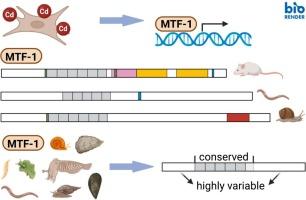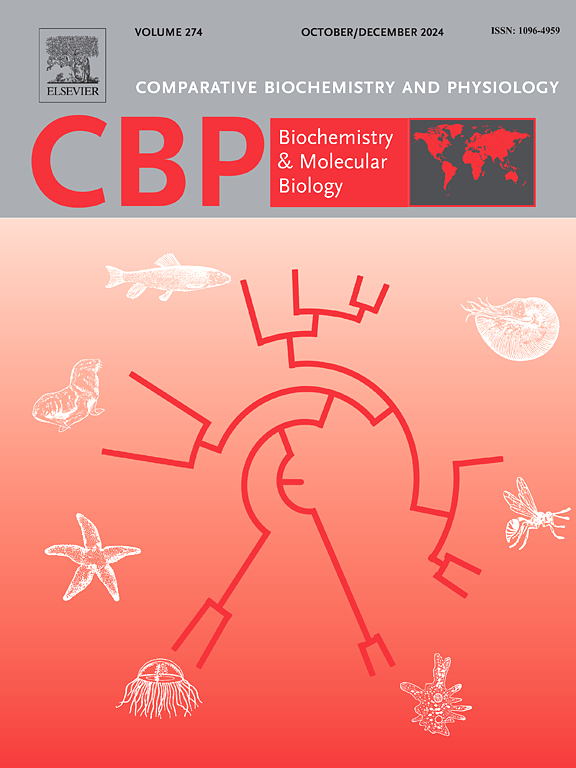Structural and functional plasticity of metal-responsive transcription factor 1 (MTF-1) within Lophotrochozoa
IF 1.8
3区 生物学
Q4 BIOCHEMISTRY & MOLECULAR BIOLOGY
Comparative Biochemistry and Physiology B-Biochemistry & Molecular Biology
Pub Date : 2025-06-07
DOI:10.1016/j.cbpb.2025.111116
引用次数: 0
Abstract
Control of metal ion metabolism in animals is crucial for their survival. In this context, the regulation of metallothioneins (MTs), key proteins in metal metabolism and detoxification, by the metal regulatory transcription factor MTF-1 is well established in vertebrates and Drosophila melanogaster. However, the metal-dependent regulation of MT genes in most other invertebrates remains poorly understood, with MTF-1 so far identified in only a few invertebrate species. In the present study, we identified the presence of MTF-1 in diverse species within Lophotrochozoa. Specifically, we confirmed the functionality of MTF-1 from Helix pomatia (Gastropoda) and Lumbricus terrestris (Annelida) through in vitro co-expression studies using a dual-luciferase assay. We also demonstrate that the conserved zinc finger region appears to be the functional centrepiece of MTF-1 throughout all animal phyla, supporting core transcription factor functions across different species. In contrast, there is high variability in the up- and downstream MTF-1 sequences which may reflect the potential for additional functions, such as species- and habitat-specific adaptations. Our study provides a comprehensive framework for better understanding MTF-1 sequence and functional variability between closely and more distantly related species.

金属响应转录因子1 (MTF-1)在磷藻中的结构和功能可塑性。
动物体内金属离子代谢的控制对其生存至关重要。在这种情况下,金属调节转录因子MTF-1对金属代谢和解毒的关键蛋白金属硫蛋白(MTs)的调节在脊椎动物和果蝇中已经得到了很好的证实。然而,在大多数其他无脊椎动物中,MT基因的金属依赖性调控仍然知之甚少,迄今为止仅在少数无脊椎动物物种中发现了MTF-1。在本研究中,我们发现MTF-1存在于不同种类的浮游动物中。具体来说,我们通过使用双荧光素酶测定法在体外共表达研究中证实了螺旋pomatia(腹足动物)和Lumbricus terrestris(环节动物)的MTF-1的功能。我们还证明,保守的锌指区似乎是所有动物门中MTF-1的功能中心,支持不同物种的核心转录因子功能。相反,上游和下游的MTF-1序列具有很高的变异性,这可能反映了其他功能的潜力,例如物种和栖息地特异性适应。我们的研究为更好地理解MTF-1序列和近亲和远亲物种之间的功能差异提供了一个全面的框架。
本文章由计算机程序翻译,如有差异,请以英文原文为准。
求助全文
约1分钟内获得全文
求助全文
来源期刊
CiteScore
4.60
自引率
4.50%
发文量
77
审稿时长
22 days
期刊介绍:
Comparative Biochemistry & Physiology (CBP) publishes papers in comparative, environmental and evolutionary physiology.
Part B: Biochemical and Molecular Biology (CBPB), focuses on biochemical physiology, primarily bioenergetics/energy metabolism, cell biology, cellular stress responses, enzymology, intermediary metabolism, macromolecular structure and function, gene regulation, evolutionary genetics. Most studies focus on biochemical or molecular analyses that have clear ramifications for physiological processes.

 求助内容:
求助内容: 应助结果提醒方式:
应助结果提醒方式:


